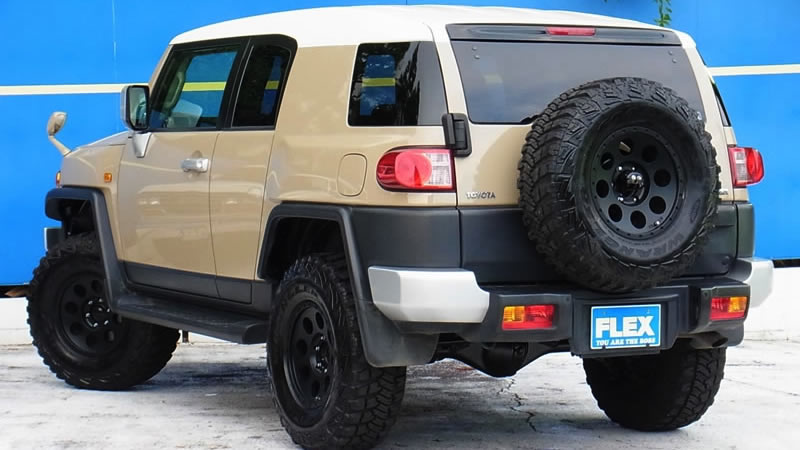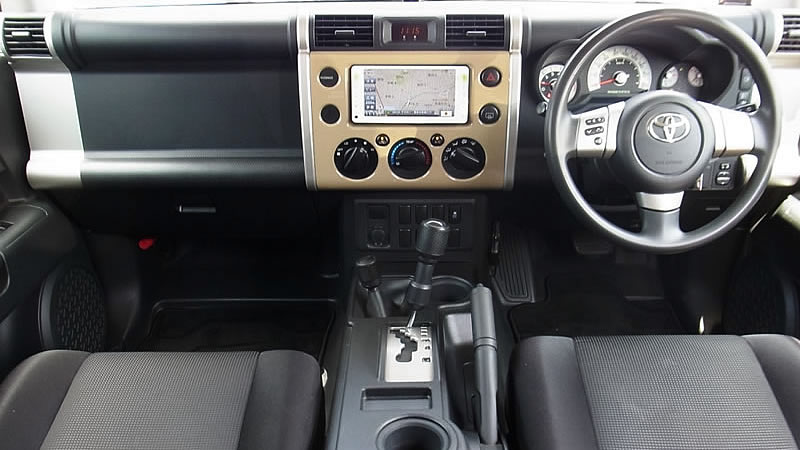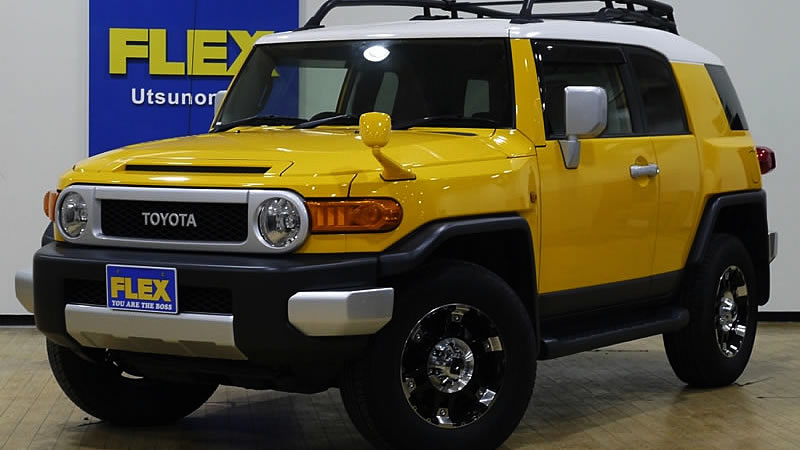Exterior
Contemporary design with Land Cruiser 40 series motif
The FJ Cruiser was designed based on the Land Cruiser 40 series. The round headlights and the oval front grill that surrounds them, the quarter window that wraps around the rear corner and a white roof are reminiscent of the 40 series.
It must have been a challenge to recreate the older style for a newer car. For example, in the 40 series, the headlamps were centered, but the current law requires that the optical axis of the headlights be placed within 400mm/15.75 inches from the outside of the body, and the FJ Cruiser naturally complies with the law.
In addition, while the overall body looks square, it has a rounded form that makes it more aerodynamic. Even with the 40 series as the inspiration, the new FJ Cruiser is modern enough to make you feel like you are in the future rather than the past.

Functionality is the focus in the FJ Cruiser’s design
At first glance, the FJ Cruiser looks like a 2-door, but it actually is a center pillar-less, left-right opening 4-door. Toyota took care to make the side view appear to be a coupe, not just because it is aesthetically pleasing, but because it is an effective as a way to make getting in and out of the rear seat easier in a short wheelbase.
In addition, the classic 4WD silhouette contributes to its ability to maneuver over rough roads. The approach angle, departure angle, ramp breakover angle, and other ground obstacle angles are large enough for a full-fledged 4WD, reducing the risk of contact with the ground on rough roads. An upright windshield and large door mirrors help improve visibility.
The use of unpainted plastic for bumpers and overfenders is also convenient for off-road driving. When it comes to the strengths of the FJ Cruiser, everyone mentions its fun design, but it’s also a great vehicle for off-road driving, as well as everyday use.
Interior

An interior that emphasizes the toughness of the 4WD
Like the exterior, the interior has the feel of an SUV. The linear dashboard, colored center cluster, and door trim, and perfectly circular switches create a retro mood reminiscent of the Land Cruiser 40 series.
A small accessory case with a lid on the instrument panel in front of the driver’s seat is a clever addition, and when you open the door, you can see the truss structure-like pattern on the side of the dashboard. There are many switches such as the one for various traction devices, but they are centrally located within easy reach.
The instrument panel is analog with white characters that are easy to read instead of a digital panel. The shift lever, transfer lever, door handle, etc. are all large, and the air conditioner is operated with a classic dial type. All of these bolder features help to accentuate the fact that this is a 4WD and it is tough.
There have been no major design changes to the interior from 2010 to the present (2015), but the “off-road package” car added a switch to the overhead console along with the adoption of new equipment such as crawl control.
Engine

It comes equipped with a 4-liter V6 gasoline engine
As of 2015, the only engine installed in the FJ Cruiser is a 4-liter V6 gasoline 1GR-FE type. It was developed exclusively for SUVs, with a nearly square stroke of 94.0 x 95.0mm bore x 95.0mm stroke, excellent torque characteristics at low and medium speeds, and an emphasis on durability.
In addition to the FJ Cruiser, it has also been installed in the 120 series Prado and Hilux Surf, which are the base models, and its reliability is certified. With a maximum output of 276PS/272 HP (203kW) at 5,600rpm and a maximum torque of 38.8kg・m /280 lb.-ft.(380N・m) at 4,400rpm, it boasts plenty of power. Dual VVT-i, which controls the valve timing of both the intake and exhaust, has a flat power characteristic, and the body, which weighs just under 2 tons, can be driven on and off-road.
The main point of this engine is that it has an advanced design and is a regular specification with excellent fuel economy. The fuel consumption is 8.0km/liter/ 18.81 MPG (JC08 mode), which is not bad for a 4-liter class. The combined drive system is only 5-speed AT + part-time 4WD. In addition, a 6-speed MT + full-time 4WD is also available for export to North America.



